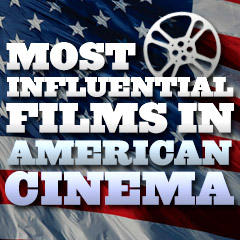Most Influential, Significant
and Important Films in American Cinema
(chronological by time period and film title)
|
|
Title Screen
|
Film Title/Year/Director/Length/Studio,
Descriptions of Influence/Significance |
Poster
|
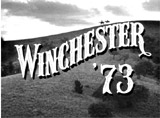
|
Winchester '73 (1950)
d. Anthony Mann, 92 minutes, Universal International Pictures
- Anthony Mann's "psychological" western about
a man on a dogged quest for a prized gun, the title character -
initiated a cycle of more serious-minded western films. It reinvented
the western genre, and this landmark film was largely responsible
for the renewed popularity of Westerns in the 1950s.
- It was the first of eight films that star James
Stewart made with Mann (five of the eight were westerns, including Bend
of the River (1952), The Naked Spur (1953), The Far Country (1954), and The
Man from Laramie (1955)).
- Studio control of stars further eroded (the first
major dent in the studios since the advent of the talkies) when
James Stewart signed a precedent-setting independent (or free-lance)
contract to share in the box-office profits (45% of the net profits)
of this film, and for the film version of the stage comedy Harvey
(1950).
The first-ever back-end deal was negotiated by legendary agent
Lew Wasserman.
- In fact, for all of Stewart's Universal Studios
films (including Bend of the River (1952), and The Far
Country (1954)), he took no salary in exchange for a large
cut of the gross profits -- which turned out to be a very lucrative
deal. For Winchester '73 alone, Stewart earned between $500,000
and $600,000. As a result, he earned increasingly high salaries,
became a pioneer of the percentage deal (a performer accepted a
reduced or non-existent salary in exchange for a percentage of
the box office profits), and was the industry's top box-office
star by mid-decade.
- This
deal proved to be enormously profitable for Stewart and allowed
him greater creative control for future pictures. Stewart's
deal soon become the norm and forever changed the studio-agent-actor
relationship. It led to the demise of the long-term contract
and the studio system.
|

|

|
A Streetcar Named Desire (1951)
d. Elia Kazan, 122/125 minutes, Charles K. Feldman Group/Warner Bros.
- Kazan's film was a subversive, steamy film classic
that was adapted from Tennessee Williams' 1947 Pulitzer Prize-winning
play of the same name.
- The visceral film, considered controversial,
decadent, and "morally repugnant" challenged the regulatory
Production Code's censors (and the Legion of Decency) with its
bold adult drama and sexual subjects (insanity, rape, domestic
violence, homosexuality, sexual obsession, and female promiscuity
or nymphomania). Ultimately, it signaled the weakening of Hollywood
censorship (and groups such as the Catholic Legion of Decency),
although a number of scenes were excised, and new dialogue was
written.
- It was the first production to come from Elia Kazan’s
Actors Studio (founded in 1947), and first presented on Broadway.
It was highly unusual to have nine members of the original Broadway
cast reprise their roles in the film - including Marlon Brando,
Kim Hunter, and Karl Malden (Vivien Leigh replaced Jessica Tandy).
- 27 year-old Marlon Brando, in his second screen
role and recreating his 1947 Broadway role (premiered
on December 3, 1947), delivered an overpowering, memorable, and
raw naturalistic performance (an example of the Method approach
to acting that he learned at the Actors Studio in New York under
Stella Adler) as a sexually-powerful, animalistic, brooding primal
brute - Stanley Kowalski.
- The film's jazzy score by composer Alex North was
the first of its kind - earning its place in the history of film
music. It was the first all-jazz score ever written for a motion
picture.
- The controversial film was nominated for a phenomenal
twelve nominations and awarded four Oscars (an unprecedented three
were in the acting categories): Best Actress for Vivien Leigh (her
second Best Actress Oscar), and Best Supporting Awards to Kim Hunter
and Karl Malden. This was the first time in Academy history
that three acting awards were won by a single film (this feat was
later repeated by Network (1976)). Humphrey
Bogart's Best Actor win for The African Queen
(1951) was an upset, since
it denied the predicted clean-sweep for the cast of the film,
and a much-deserved Oscar for Brando.
|

|

|
Bwana Devil (1952)
d. Arch Oboler, 79 minutes, Gulu Productions/Oboler/United
Artists
- An exploitative jungle adventure film - noted as
the first 3-D feature-length, commercially-released color (and
sound) film ever made - from an independent studio. [Note:
The first feature-length 3-D film was the silent film, The Power
of Love (1922).]
3-D technology was employed to try to combat the encroaching competition
of television on the film industry. The 3-D
effect, however, was unable to fully compensate for the inferior
level of most of the films.
- It inspired a flood of other quickly (and often
cheaply made), but sometimes successful 3-D features. The 'golden
age' of 3-D was ushered in from 1952-1955, with films such as Robot
Monster (1953), It Came From Outer Space (1953), Columbia's Man
in the Dark (1953), and House of Wax (1953).
- There were other short-lived film fads in this
decade and afterwards that were designed to tear viewers away
from their TVs (i.e., Aroma-Rama, Smell-O-Vision, etc.) and lots
of gimmicks from hucksters like 50s B-horror film director and
impresario schlockmeister William Castle.
- It came in the same year as the debut of This
is Cinerama (1952), when showmanship and gimmicks like 3-D
were used to bring audiences back. Special polarized, 'stereoscopic'
goggles or cardboard glasses worn by viewers made the action
jump off the screen - in reality, the glasses were unpopular,
clunky and the viewing was blurry, although it was difficult
(and expensive) for theatre owners to get cinema-goers to give
them back.
- The film featured man-eating Tsavo lions leaping
toward the camera and flying spears thrown out of the screen.
|

|
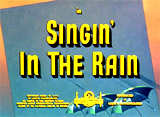
|
Singin' in the Rain (1952)
d. Stanley Donen and Gene Kelly, 103 minutes, MGM
- One of the all-time best Hollywood musicals that
spoofed and satirized the transitional chaos surrounding the end
of the silent film era and the dawn of the 'talkies.' Set
in the year 1927, it humorously parodied the panic surrounding
the troubling transitional period from silents to talkies in the dream
factory of Hollywood of the late 1920s as the sound revolution swept
through.
- The joyous film, co-directed by Stanley Donen and
acrobatic dancer-star-choreographer Gene Kelly, was a charming,
up-beat, graceful and thoroughly enjoyable experience with great
songs, lots of flashbacks, wonderful dances (including the spectacular Broadway
Melody Ballet with leggy guest star Cyd Charisse), casting
and story.
- It became one
of the most-loved and celebrated film musicals of all time from
MGM, before a mass exodus to filmed adaptations of Broadway plays
emerged as a standard pattern. It was made directly for film, and
was not a Broadway adaptation.
- This was another extraordinary example of the organic,
'integrated musical' in which the story's characters naturally
expressed their emotions in the midst of their lives. Song and
dance replaced the dialogue, usually during moments of high spirits
or passionate romance. And over half of the film - a 'let's put
on a play' type of film, was composed of musical numbers.
- It featured Gene Kelly's heart-lifting, enchanting
dance scene during a cloudburst, when he performed a glorious,
almost five minute performance of the title song "Singin'
In the Rain" - a spontaneous expression of his crazy-in-love,
euphoric mood and happiness over his new-found love for Kathy Selden
(Debbie Reynolds).
- This superb film, called "MGM's TECHNICOLOR
Musical Treasure,"
was produced during MGM studios' creative pinnacle. From the late 1930s to
the early 1960s, producer Arthur Freed produced more than forty musicals
for MGM. The creative forces at the studio in the Freed Unit - composed of
Freed, Vincente Minnelli, Stanley Donen, and actor-choreographer Gene Kelly
- also collaborated together to produce such gems as Meet
Me in St. Louis (1944), The Pirate (1948), On the Town (1949),
Best Picture Oscar-winner a year earlier with director Vincente Minnelli
- An American in Paris (1951), Royal Wedding
(1951), Seven Brides for Seven Brothers (1954), and Gigi (1958).
- Surprisingly, this great film that was shot for
a cost of $2.5 million (about $.5 million over-budget), was basically
ignored by film critics when released and treated with indifference
(with box-office of $7.7 worldwide). Although generally considered
the greatest screen musical of all time, it had only two Oscar
nominations (without a win) -- Best Score and Best Supporting Actress
(Jean Hagen).
- Now, after many accolades, television screenings,
and its resurgence after the release of That's Entertainment
(1974), it is often chosen as one of the all-time top ten American
films, and generally considered Hollywood's greatest and finest
screen musical. Great care was made to authenticate the costumes,
the sound studio set, and other historical details in the film.
The film's title song was paid twisted homage (of sorts) in Stanley
Kubrick's A Clockwork Orange (1971) during
the brutal rape scene.
- In the story, vaudeville,
silent film actor/dancer Don Lockwood (Gene Kelly) and co-star
actress Lina Lamont (Jean Hagen) were at the height of box-office
popularity, but with the advent of sound, shrill-voiced Lina's
first talkie The Duelling Cavalier with swashbuckling
Lockwood was laughable before studio preview audiences. His aspiring
ingenue girlfriend Kathy Selden (Debbie Reynolds) was recruited
to rescue their first film - remade as a musical re-titled The
Dancing Cavalier, with Kathy secretly dubbing over Lina's
voice. The voice-dubbing deception was ultimately exposed, and love
blossomed. With marvelous musical numbers including the title song "Singin'
in the Rain," and "You Were Meant for Me," "Make
'Em Laugh," "Broadway Melody," and "All I Do
Is Dream of You."
|

|

|
The Robe (1953)
d. Henry Koster, 135 minutes, 20th Century Fox
- In further desperate warfare against television
and rival 3-D movies to lure back viewers to theatres, Hollywood
developed grander, wide-screen processes, such as 20th Century
Fox's anamorphic CinemaScope,
first released and seen in Henry Koster's Biblical sword-and-sandal
epic The
Robe (1953).
CinemaScope was one of the first successful widescreen
(or panoramic) processes.
- The film was the first motion picture in CinemaScope to
be nominated for the Best Picture Academy Award.
- The groundbreaking film was introduced by the studio's
head Spyros Skouras, and helped to save the movie industry from
the onslaught of its major competitor - television.
|

|

|
The Wild One (1953)
d. Laslo Benedek, 79 minutes, Columbia Pictures/Stanley Kramer Productions
- This was a landmark film
of 50s rebellion by director Laslo Benedek, producer Stanley Kramer,
and screenwriter John Paxton. It was the first feature film to
examine outlaw motorcycle gang violence in America, and seemed
frightening to many average Americans.
- It was a semi-documentary
film, inspired by a real-life incident over the Fourth of July
weekend in 1947 in Hollister, California that involved thousands
of motorcyclists and other visitors and enthusiasts who roared
into the town over a two day period, and overwhelmed the facilities.
- In contrast to serious, social-minded films of the
50s, this was the first financially-successful "teen film" -
it also challenged the strong Production Code in effect at the
time. It was directly marketed to youthful audiences. It appealed
to disaffected youth (and young adults who didn't fit in) who felt
like outcasts from the "affluent" suburban-dwelling families living
in the post-war era. One of the film's taglines on its posters
stated: "Hot
feelings hit terrifying heights in a story that really boils over!"
- James Dean's disaffected, frustrated youth Jim Stark
in Rebel Without a Cause (1955),
Elvis Presley's anti-hero character in Jailhouse Rock (1957),
and even the significant counter-cultural Easy
Rider (1969) - plus a spate of exploitation biker films
(i.e., Roger Corman's trashy B-film classic The Wild Angels
(1966)) - owe their existence to this original, cult classic
film.
- Because of the controversial nature of the film,
public screenings were banned in England by the British Board of
Film Censors for fourteen years (until 1968) after its release.
Even in America, it was feared that the shocking, 'Communist' movie
glamorized an anti-social subculture ("motorcycle toughs") in revolt,
would set a bad example, and cause impressionable viewers to copy-cat
its plot and incite deliquency and riots. In fact, it took many
years for pacifist motorcyclists to overcome stereotypes and fabrications
promoted by the film.
|

|

|
Blackboard Jungle (1955)
d. Richard Brooks, 101 minutes, MGM
- This shocking, cautionary tale, urban melo-drama
and striking film with social commentary was about education in
a violent, inner-city US boys school (the "blackboard jungle").
The school had a number of budding, undisciplined punks and juvenile
delinquents with switchblades who terrorized each other and their
teachers. It was the first American film to deal with the social
problem of teenage delinquency and classroom anarchy in our urban
public schools.
- Sidney Poitier starred as Gregory Miller, a disaffected,
inner city young black student, while Vic Morrow portrayed the
insolent, delinquent gang leader and class bully Artie West. The
main protagonist was the new teacher Richard Dadier (Glenn Ford)
at North Manual High School who faced resistance from his students
and other more experienced teachers.
- It appealed to large teenage audiences,
who often became so involved and uninhibited (i.e., dancing in
the aisles) that screenings sometimes led to violence
and vandalism. The disturbing film was banned in some US cities
for inciting anti-social (and anti-American!) behavior. Theatrical
showings exhibited what would soon be recognized as the first evidence
of teenage rebelliousness, to blossom later in the decade and future
years.
- It was the first film to feature a rock-'n'-roll
song: "Rock-Around-The-Clock" (sung
by Bill Haley and His Comets during the opening credits, and used
in the film's closing). It was the first major Hollywood film to
use R&R
on its soundtrack, making it one of the most influential film soundtracks
of all time. It inspired the next year's
popular R&R
film, Rock
Around the Clock (1956).
|
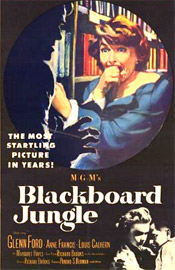
|

|
The Man With the Golden Arm (1955)
d. Otto Preminger, 119 minutes, Otto Preminger Films/Carlyle Productions/United
Artists
- This socially-conscious film was one of the first
attempts by Hollywood to deal with the issue of drug use - its
censor-defying, ground-breaking topic. It was the first big-budget
cautionary tale about the horrors of drug abuse, and daring as
a major Hollywood film to star A-list actors with this story-line.
- Iconoclastic director Otto Preminger took on the
challenging of making this film about drug addiction, as a vehicle
for breaking the Production Code's restrictions on portrayals of
those addicted to illegal drugs. Preminger knew that he was have
to defy and fight the Production Code (and the MPAA), as he had
done earlier with The
Moon Is Blue (1953).
- At first, United Artists withdrew from the Motion
Pictures Association of American (previously named the MPPDA) when
it refused to issue a Production Code seal to its controversial
film about drug addiction, starring singer/actor Frank Sinatra
in a naturalistic, incredible Oscar-nominated performance as rehabilitated
junkie Frankie Machine on a downward spiral as he returned to his
life as a drug abuser.
- The film's success helped to loosen restrictions
on such films, and allowed more difficult topics to be explored
in the movies. The code was amended to permit portrayals of drugs,
kidnapping, prostitution and abortion as well as light profanity
(the use of the words 'hell' and 'damn'). Although nothing like
more graphic future 'drug-horror' films such as Darren Aronofsky's Requiem
For a Dream (2000), it had a significant impact on film-making,
especially its scene of Frankie going 'cold-turkey.'
- The famed graphic
designer Saul Bass made his most lasting impact on the movies, with
his designs for movie title screens.
He was known as the man who
invented the opening credit sequence - he incorporated the title
screen into the film itself with striking images. He transformed
and elevated static title screens into stylized, moving works of
art, first most dramatically with his jagged, twisted and deconstructed
forearm that moved (a symbol of heroin addiction) for The Man
With the Golden Arm (1955).
- The film was also enhanced by the pulsating, jazz
score by Elmer Bernstein.
|

|
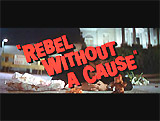
|
Rebel Without a Cause (1955)
d. Nicholas Ray, 111 minutes, Warner Bros.
- This classic, melodramatic film made James Dean
an anti-hero icon for generations to come - this was the second
of his three films and the best archetypal 50s film of its kind
regarding the generation gap.
- Director Nicholas Ray's first film in Cinemascope told
a story of rebellion and angst in the life of an unsettled, teenaged,
new-kid-in-town Jim Stark (Method actor James Dean) who crossed
paths with two other alienated, misfit youth - Judy (Natalie Wood)
and Plato (Sal Mineo) - at a police station in the first sequence.
The outcast trio of juveniles formed a strong bond (or "family")
against both their insensitive parents (completely unjust, dysfunctional,
ineffectual, or callous) and their peers, as they searched for
their identities.
- This reactionary film is considered Hollywood's
best 50's film of rebellious and restless youth (and sex, drugs,
and rock 'n' roll) that spawned many other lesser teen exploitation
films in its wake. [Other films that caused the same sensation
included the earlier 50s films The Wild One
(1953) with Marlon Brando and Blackboard Jungle (1955).] Other
films that arose in the juvenile delinquent subgenre included I
Was a Teenage Werewolf (1957), Roger Corman's Teenage Doll
(1957), High
School Confidential! (1958), T-Bird
Gang (1959),
and Tony Richardson's British film The Loneliness of the Long
Distance Runner (1962, UK).
- This film sympathetically viewed rebellious, American,
restless, misunderstood, middle-class youth. The tale of youthful
defiance, which could have been exploitative (but wasn't), provided
a rich, but stylized (and partly out-dated) look at the world of
the conformist mid-1950s from the perspective of the main adolescent
male character - a troubled teen with ineffectual parents, who
faced a new school environment.
- The film received only three Academy Awards nominations
(without wins): Best Supporting Actor (Sal Mineo with the first
of two unsuccessful career nominations), Best Supporting Actress
(Natalie Wood with the first of three unsuccessful career nominations),
and Best Motion Picture Story (Nicholas Ray). It wasn't nominated
for either Best Picture (won by the short, unassuming romantic
drama Marty (1955)) or Best Director
for Nicholas Ray. Ironically, Dean was not nominated for his role
in this film (although it eventually became his iconic career role),
but was nominated instead for his Best Actor performance as insecure,
tortured, neurotic loner and unappreciated son Caleb "Cal" Trask
in his first major film role, East of Eden
(1955).
- The colorful wide-screen Cinemascope feature is
most remembered for being the film that best presented the talent
of top-billed, 24 year-old charismatic cult star James Dean, shortly
before his premature death in 1955. It opened at the Astor Theatre
in New York on October 29th, 1955, about a month after the death
of its star (on September 30, 1955) on a California highway in
his sports car.
- It also served as a springboard for the acting careers
of its two other stars Natalie Wood (in her first non-child 'adult'
role) and unknown 16 year-old actor Sal Mineo. It afforded a classic,
semi-glamorized portrait of three troubled, frustrated, anguished,
and identity-seeking teenagers - all outsiders, alienated and outcast
from the world and values of parents and adults, who attained maturity
through rebellion and tragic circumstances. In the film, Dean formed
a friendly bond with the other two characters: Wood as confused
teenaged Judy, and Mineo as a strange, adoring boy named Plato
- the film's sacrificial lamb by film's end.
- It
has been surmised that Sal Mineo's teen-aged character in the film
was obviously gay and troubled by typical problems of in-the-closet
homosexuals in the 50s - the film disguised his problems, but hinted
at the possibility that he was seeking out Dean's character because
he rejected fake machismo.
|

|

|
The Searchers (1956)
d. John Ford, 119 minutes, Warner Bros.
- A true American masterpiece of filmmaking, and
the best, most influential, and perhaps most-admired film of director
John Ford. However, the sophisticated, modern,
visually-striking film was unappreciated, misunderstood, and unrecognized
by critics. It did not receive a single Academy Award nomination.
- The film's complex, deeply-nuanced themes included
racism, individuality, the American character, and the opposition
between civilization (exemplified by homes, caves, and other domestic
interiors) and the untamed frontier wilderness.
- The Searchers genre-breaking western tale
was the emotionally complex story of a perilous, hate-ridden quest
and Homeric-style odyssey of self-discovery (after a Comanche massacre)
by John Wayne's character - obsessed Indian hunter Ethan Edwards.
In Wayne's first anti-heroic role, he portrayed a bigot and racist
- a tragic, lonely, morally-ambiguous figure perenially doomed
to be an outsider. It was a role that the actor often described
as his favorite. It has commonly been regarded as Wayne's finest-acted
performance - and his ninth starring
role in a Ford film.
- Its exploration of the themes of racial prejudice
and sexism made it one of cinema's earliest examples of an attempt
to portray racism in US-Native American relations.
- Ten to fifteen years after the film's debut, and
after reassessing it as a cinematic milestone, a generation of "New
Hollywood"
film directors, French film critics and others, including Martin Scorsese,
Paul Schrader, Steven Spielberg, John Milius, Brian De Palma, Jean-Luc Godard,
Wim Wenders, and George Lucas, praised the film. They traced their own fascination
with film to this mythic John Ford western, and in reverence, reflected his
work in their own films (e.g., Scorsese's Taxi Driver
(1976), Who's That Knocking at My Door? (1968), and Mean
Streets (1973), Lucas' Star Wars (1977),
Spielberg's Close Encounters of the Third Kind (1977),
Sergio Leone's Once Upon a Time in the West (1968, It.), and Schrader's Hardcore
(1979)).
|

|

|
The Ten Commandments (1956)
d. William Wyler, 220 minutes, Paramount Pictures
- Legendary producer/director Cecil B. DeMille remade
his own 1923 silent epic -- it was his last film, and his first and
sole widescreen feature film. DeMille had his 75th birthday
during the production of this film, making him the oldest working
Hollywood director at the time.
- The blockbuster film (3 hours and 40 minutes long)
made with VistaVision was produced with an exorbitant budget of
$13 million - the costliest picture made to date.
- A quintessential Biblical epic, it featured
the great scene of Moses (Charlton Heston) parting the Red Sea, for
which (in part) it won its sole Oscar - Best Special Effects.
It was nominated for seven Academy Awards including Best Picture,
and provided actor Edward G. Robinson with a comeback role after
he was unfairly blacklisted in the 1950s.
- It became Paramount's biggest grossing movie up
to that time, and second only to Gone with
the Wind (1939). It
was the highest-earning live-action film of the 1950s, with The
Sound of Music (1965) eventually
breaking its streak. Although a blockbuster, the film reverted
to melodramatic style, with great actors adopting static attitudes,
postures and gestures.
- For many years, it was an annual event to watch
the film on TV at Easter time (and Palm Sunday) or Passover. It
remains one of the main sources of American knowledge about the
Exodus story.
- Some reports have claimed (although challenged)
that the film mobilized the greatest number of extras
ever used in a motion picture - estimates speculated there were
seven to ten thousand extras, with approximately 5,000 head
of livestock.
- The film forever stereotyped Charlton Heston (the
Moses figure) as a major character in similar
epics, such as Ben-Hur
(1959), El Cid (1961), The Agony and the Ecstasy
(1965), and The Greatest Story Ever Told (1965).
|

|

|
Shadows (1959)
d. John Cassavetes, 81 minutes, Lion International Films
- Pioneering independent filmmaker, writer/director
John Cassavetes' low-budget ($40,000), controversial, pre-cinema-verité first
feature film has often been cited as the start of the independent
(or indie) feature film movement in the US with its daring subject
matter (about an inter-racial love affair), mostly improvised dialogue,
and a non-professional cast and crew. The film was first shot in
1957 (with a16 mm hand-held camera), then screened, re-edited and
re-shot in the following years, and re-released.
- After this crudely-made, grainy film, Cassavetes
- who was dubbed "the father
of new American independent cinema," turned to studio films
for a few years, but then after finding studio films too restrictive,
he resumed low-budget, independent filmmaking stretching into the
70s.
- He returned to his highly individualistic style
and realistic, stark cinema verité (with
unscripted and often inaudible dialogue, poor lighting, and improvisational
character studies in overlong, amateurish and ragged films made with
a hand-held camera).
- Shadows ultimately influenced the development
of underground films (Jack Smith, Andy Warhol, Paul Morrissey,
Kenneth Anger), and other camp-trash directors (John Waters,
'Gore-Godfather' Herschell Gordon Lewis) and many other film-makers
(David Lynch) mostly independent of the traditional studio system.
- John Cassavetes' later film Faces (1968) was
the first independently-made
and distributed American film to reach mainstream audiences.
|

|
